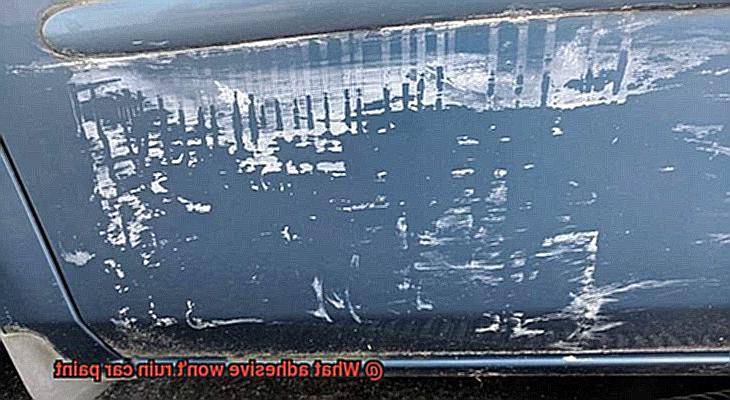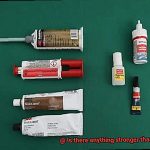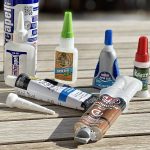Are you tired of dealing with adhesive residue or paint damage on your car after trying to remove a sticker or decal? It’s frustrating, to say the least. But fear not, fellow car enthusiasts. As an expert in the field, I’m here to provide you with the solution.
In this blog post, we’ll dive into the world of adhesives for car customization and explore which ones won’t ruin your precious paint job. We’ll cover everything from double-sided tapes to foam tapes and automotive-specific adhesives. Plus, we’ll discuss the advantages and disadvantages of each type so you can make an informed decision.
But it’s not just about finding an adhesive that won’t damage your car’s paint. We’ll also discuss factors like weather and surface type that can affect the effectiveness and longevity of your chosen adhesive.
So whether you’re looking to add some personality to your ride with decals or simply need a reliable adhesive for repairs, this post has got you covered. Say goodbye to unsightly residue and hello to a perfectly customized car – all thanks to the right adhesive choice.
Trust me, finding the right adhesive can be a game-changer for your car customization journey. Keep reading to discover what options are available and how they can benefit you.
What is Car Paint?
Contents
Car paint is the first thing that catches our eye when we see a car. It’s a coating applied to the surface of a vehicle to protect it from environmental factors such as sunlight, moisture, and dirt. But it’s not just about protection. It also enhances the aesthetic appeal of the car by providing a glossy or matte finish.
Car paint typically consists of four layers: the primer, the base coat, the clear coat, and a protective layer. The primer is applied first and serves as a bonding agent between the car’s surface and the base coat. The base coat provides the color and texture of the car’s paint job. The clear coat is then applied on top of the base coat to protect it from scratches, chips, and fading. Finally, a protective layer may be added to provide additional protection against environmental factors.

Different types of materials can be used to create car paint, including acrylic lacquer, enamel, urethane, and water-based paint. Each type of paint has unique properties designed for specific applications. Some paints are more durable than others, while others offer better color retention.
However, car paint is not invincible. It can be damaged by exposure to harsh chemicals or abrasives. Therefore, it is essential to use products specifically designed for car care when cleaning or repairing a vehicle’s surface. Using the wrong type of adhesive can also damage car paint.
When it comes to adhesives for cars, there are several safe options available that won’t harm your car’s paint. 3M Automotive Attachment Tape is specifically designed for automotive use and is ideal for attaching exterior trim and emblems. Silicone adhesive is commonly used in automotive applications because it can withstand high temperatures and weather conditions. Double-sided foam tape is another excellent choice for attaching parts to your car without damaging the paint.
Why Adhesive Selection Matters
Not only does it enhance the aesthetics of your car, but it also protects it from weather elements. That’s why when it comes to working on your car’s exterior, adhesive selection matters significantly.
Choosing the wrong adhesive can lead to costly repairs and an unappealing finish. It’s essential to avoid this mistake by selecting adhesives that will not damage your car’s paint. Unfortunately, not all adhesives are created equal, and some are designed for specific materials, which may result in damage to painted surfaces. Therefore, it’s critical to choose an adhesive that is safe for use on painted surfaces.
Another reason why adhesive selection matters is because different adhesives have varying levels of strength. Some adhesives are designed for temporary use and may not hold up well over time, while others are designed for permanent bonding and can withstand extreme conditions. Choosing the right adhesive strength is vital to ensure that it will hold up well and not fail over time.
It’s also worth noting that some adhesives contain solvents that can dissolve or soften the paint, leading to further damage. For this reason, it’s crucial to select adhesives that are safe for use on painted surfaces.
In conclusion, adhesive selection matters when working on a car’s exterior to prevent costly damage to the paint job and ensure an appealing finish. To achieve this, select an adhesive that is safe for use on painted surfaces and has the appropriate level of strength for the intended application.
3M Automotive Attachment Tape
This double-sided tape is a game-changer in the industry, designed specifically to bond automotive parts and accessories without harming your car’s paint. It is made up of a strong acrylic foam core that provides excellent adhesion, making it a reliable choice for car manufacturers and enthusiasts alike.
One of the best things about 3M Automotive Attachment Tape is how easy it is to use. It comes in a roll that can be cut to any size required, perfect for any DIY project. The red liner helps with alignment and application, ensuring a perfect finish every time.
What’s more, this tape has been tested and approved by many car manufacturers, making it a trustworthy choice for professionals and enthusiasts alike. It is also waterproof and resistant to UV rays, ensuring that its bond will remain intact even in harsh weather conditions.
However, it’s always important to test the tape on a small area before applying it to the entire surface to ensure that it doesn’t cause damage or discoloration to your car’s paint.
Silicone Adhesive
Silicone adhesive is a versatile and popular choice for automotive applications due to its ability to withstand extreme temperatures and weather conditions while providing a strong and flexible bond. However, using silicone adhesive on car paint requires careful consideration to avoid damaging the paint or leaving behind unsightly residue.
The first step in using silicone adhesive on car paint is to choose a high-quality product specifically designed for automotive use. This will ensure that the adhesive does not harm the paint or leave any residue behind. Additionally, it is important to prepare the surface thoroughly by cleaning it of any dirt, debris, or oils before applying the adhesive.
When applying silicone adhesive, it is important to follow the manufacturer’s instructions carefully. This may require using a specific amount of adhesive, applying it in a particular way, or allowing it to cure for a certain period of time before use. Deviating from these instructions can lead to poor bonding or even damage to the car paint.
Silicone adhesive can be used on a variety of automotive surfaces such as windshields, mirrors, and body panels. It is particularly useful in areas that are exposed to harsh elements like extreme temperatures and weather conditions. The flexibility of silicone adhesive also makes it ideal for use in areas that experience vibration or movement.
Double-Sided Foam Tape
Look no further than automotive-grade double-sided foam tape. This versatile adhesive is easy to use and provides a strong bond, making it an ideal choice for various applications, including automotive.
However, not all double-sided foam tapes are suitable for cars. It is crucial to choose a product specifically labeled as “automotive-grade” or “vehicle-grade” to ensure that it won’t damage your car’s paint. Automotive-grade tapes are formulated with high-quality adhesive that can withstand extreme temperatures and weather conditions, making them perfect for use on cars.
But not all automotive-grade double-sided foam tapes are created equal. It’s essential to choose a reputable brand and read reviews before making a purchase. Some brands may offer different levels of adhesion or durability, so it’s crucial to do your research before selecting a tape.
Using high-quality automotive-grade double-sided foam tape can be an effective and safe way to attach accessories or trim to your car without causing any damage to the paint. Here are some benefits of using automotive-grade double-sided foam tape:
- Strong Bond: Automotive-grade tapes offer a strong and durable bond that will keep your accessories securely attached.
- Safe for Car Paint: These tapes are formulated with high-quality adhesive that won’t damage your car’s paint, even in extreme temperatures and weather conditions.
- Versatile: Automotive-grade tapes can be used for various applications, including attaching emblems, moldings, and other accessories.
- Easy to Use: These tapes are easy to apply and can be cut to size, making them a convenient option for DIY projects.
Other Safe Adhesives for Car Paint
Attaching accessories can be a source of anxiety, especially if you’re worried about damaging your car paint. But fear not, because there are several safe adhesive options available on the market that won’t ruin your car’s appearance. As an expert in this field, I can tell you that choosing the right adhesive is crucial to protect the paint and maintain the overall look of your ride.
Let’s explore some of the best options out there. First up, we have double-sided automotive tape. This type of tape is specifically designed for use on car surfaces and won’t cause any damage to the paint. It’s perfect for attaching emblems, trim pieces, and body side moldings with ease. Just be sure to choose a reputable brand labeled as “vehicle-grade” or “automotive-grade” to ensure you’re getting a high-quality product.
Adhesive velcro strips are another great option for securing items such as GPS devices, cell phone holders, or other small electronics without damaging your car’s paint. These strips are easy to use and remove without leaving any residue behind. Plus, they come in various sizes and shapes, making them versatile for different accessory needs.
For more heavy-duty adhesive needs, silicone adhesives are a reliable option for attaching accessories without harming the paint. They are commonly used in automotive applications such as sealing windshields and windows. However, they may require more effort to remove than other adhesive options.
Finally, if you need a temporary solution or want to protect certain areas of your car during a project, painter’s tape is an excellent choice. This type of tape is designed to be easily removable without leaving any residue or causing any damage to the paint.
Tips for Applying Adhesives to a Car
As a car owner, you may need to apply adhesives to your vehicle for various reasons such as attaching exterior trim, emblems, or glass windows. However, it can be challenging to find the right adhesive that won’t damage your car’s paint. Here are five tips to help you apply adhesives to your car without damaging the paint.
Choose the Right Adhesive
The first and most crucial step is selecting the right adhesive. Not all adhesives are created equal, and some may be too harsh for car paint. It’s essential to read the label and ensure that the adhesive is safe for use on car surfaces. Consider options like double-sided automotive tape or silicone-based adhesives that are designed specifically for automotive applications.
Clean the Surface Thoroughly
Before applying any adhesive, clean the surface where the adhesive will be applied thoroughly. Any dirt, grease, or debris on the surface can interfere with the adhesive’s ability to bond properly. Use soap and water or a specialized cleaner designed for car surfaces to ensure a clean surface.
Apply Evenly and Thinly
When applying the adhesive, make sure to apply it evenly and thinly. This will help ensure that there are no bumps or air pockets under the adhesive, which could cause it to peel off or damage the paint. Using a small brush or applicator can help with precise application.
Avoid Directly Applying Adhesive to Painted Surfaces
If possible, avoid applying adhesive directly onto painted surfaces. Instead, apply it to a non-painted surface such as plastic or metal trim pieces. If it is necessary to apply adhesive directly onto the paint, use caution and only apply a small amount in an inconspicuous area first to test for any adverse reactions.
Let It Dry Completely
After applying the adhesive, let it dry completely before driving or washing the car. This will allow the adhesive to bond properly and reduce the risk of it peeling off or damaging the paint. Follow the manufacturer’s instructions carefully, including any recommended drying times or application techniques.
Common Mistakes to Avoid When Using Adhesives on a Car
Using the wrong adhesive or applying it incorrectly can cause damage to your car’s paint job. To avoid this, let’s take a closer look at some common mistakes that you should avoid when using adhesives on a car.
Firstly, using the wrong type of adhesive can be a big mistake. Superglue or construction adhesive may seem like quick fixes, but these types of adhesives can be too strong and difficult to remove. They can cause damage to the paint if not used carefully. It is important to choose an appropriate adhesive for the job, one that is safe for use on cars and won’t damage the paint.
Secondly, applying too much adhesive can lead to it seeping out and causing unsightly stains on the paint job. It’s essential to use just enough adhesive to do the job without overdoing it. Follow the manufacturer’s instructions for proper application and use only as much as necessary.
Thirdly, not preparing the surface properly before applying adhesive is another common mistake. It’s crucial to clean the area thoroughly with soap and water and then dry it completely before applying any adhesive. This ensures that the adhesive will bond properly and not be compromised by any dirt or debris on the surface.
Lastly, not allowing enough time for the adhesive to dry and cure can cause issues as well. Rushing to remove tape or hold something in place before the adhesive has fully cured can cause it to become undone and potentially damage the paint job in the process. It’s important to allow enough time for the adhesive to dry and cure before driving or washing your car.
t6zgyeeeawU” >
Conclusion
To sum it up, selecting the right adhesive for your car modification project is paramount to preserving the integrity of your vehicle’s paint job. You have a plethora of options at your disposal, but it’s crucial that you opt for an adhesive that is safe to use on painted surfaces and has the appropriate level of strength for your intended application. When it comes to reliable adhesives that won’t harm your car’s paint, 3M Automotive Attachment Tape, silicone adhesive, and double-sided foam tape are all excellent choices.
In addition to considering the type of adhesive you need, don’t forget other critical factors like weather conditions and surface type when making your selection. Different adhesives possess varying levels of strength and may require specific preparation or application techniques. To ensure that you’re getting a high-quality product, look for reputable brands and read reviews before making a purchase.
When applying adhesives to your vehicle, always remember to clean the surface thoroughly beforehand, apply evenly and thinly, and allow ample time for drying before driving or washing your car. Avoid common mistakes such as using the wrong type of adhesive or not allowing enough time for it to dry and cure.






